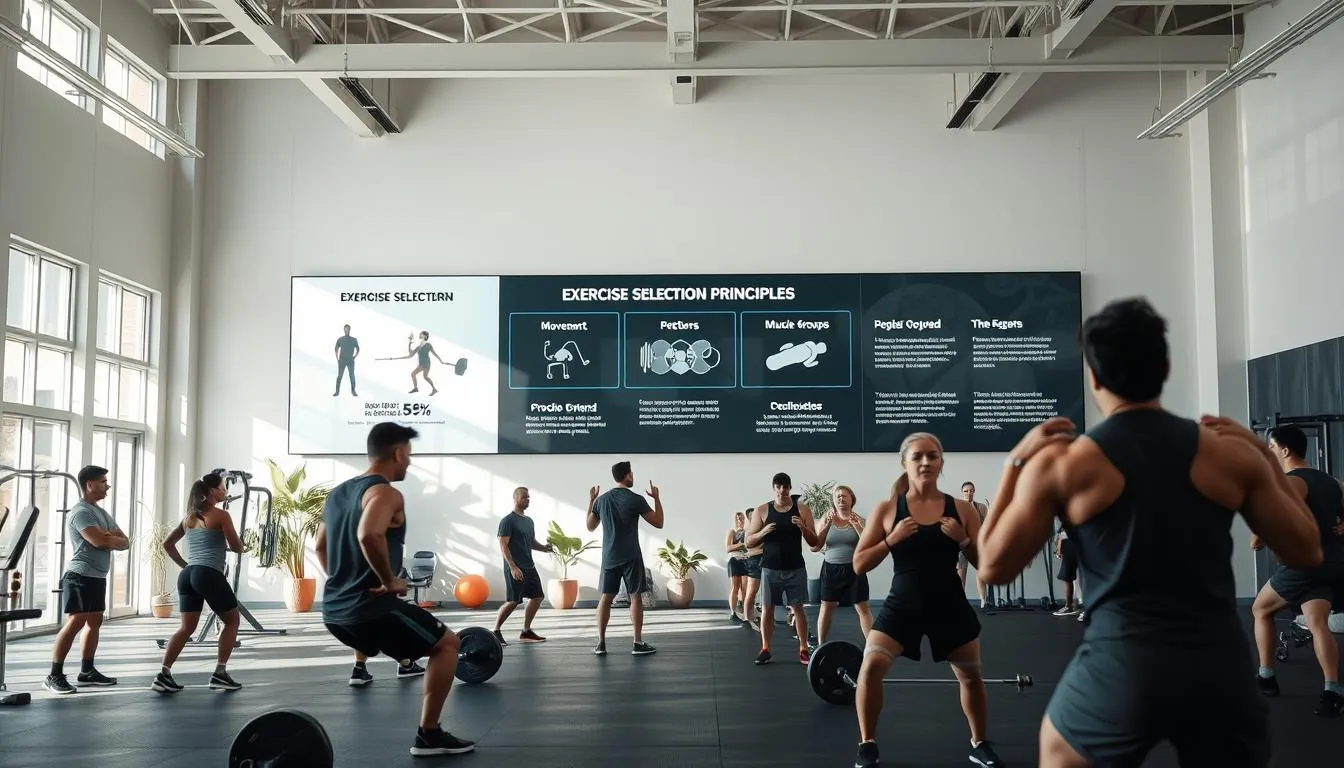70% of gym-goers say smart programs beat guesswork — a striking shift that shows how many people now expect clear, measurable progress, and consider exploring interactive resistance equipment technology for additional techniques.
Modern lifting blends science, simple systems, and digital tools to help lifters chase both size strength and steady muscle growth.
Each week now matters more because plans link muscle physiology to practical steps that drive real results. The new methods focus on mechanical tension, metabolites, and the pump to tip growth in your favor.
Recovery, protein, and sleep pair with smart programming so gains happen between sessions, not just during them. Renaissance Periodization backs this with apps: an RP Hypertrophy app that auto-adjusts workouts and an RP Diet Coach app that guides calories and meals.
Key Takeaways
- Science-first plans turn vague effort into measurable progress each week.
- Muscle growth needs tension, pump, and recovery working together.
- Nutrition and sleep matter as much as the workout itself.
- Adaptive apps keep programs aligned with your feedback.
- Follow simple, data-backed steps for the best results over time.
Why the Strength Training Renaissance Is Happening Right Now
When apps turn your weekly notes into smarter choices, progress stops being random and starts being predictable.
From guesswork to data-driven methods
People now get clear summaries of research and simple systems. Those resources cut trial-and-error and let you plan each session with purpose.
Autoregulated plans read your responses — how hard last week felt or which sets were easy — and change the plan so the muscle stimulus stays high without excess fatigue.
Access to science-backed apps and resources
RP centralizes evidence on growth, injury prevention, and nutrition. Their app and guides adjust volume, intensity, and exercise choices as you report data.
- Five-plus weekly videos speed learning so you save time on guesswork.
- Plans blend objective markers and subjective feedback to keep stress manageable for better recovery.
- The result: more effective work each week and clearer progress toward your goals.
The Science of Muscle Growth: From Stimulus to Results
Muscle growth is the result of small daily choices stacked over months and years.
Genetics set a baseline for how readily tissue builds versus breaks down. Hormones matter: testosterone supports anabolism while cortisol increases breakdown. You can nudge testosterone upward with better sleep and diet, and reduce stress more meaningfully by prioritizing rest, relaxation, and smarter workout organization.

Muscle action: tension, metabolites, and the pump
In the gym, the key drivers are high mechanical tension, metabolite buildup, and cell swelling (the pump). These actions trigger the cellular signals that lead to visible growth.
Nutrition and net balance
To tip net balance toward anabolism you need enough protein and calories. Aim for whole foods that supply micronutrients and fiber, because quality matters for repair and overall health.
Recovery, stress, and time as multipliers
Too much extra activity can become catabolic, so plan non-lifting movement to complement your work. Consistent sleep, low-intensity activity, and relaxation speed readiness between sessions.
- Practical takeaway: Pair effective stimuli with fuel and rest to convert effort into new mass and size.
- Think long-term: steady progress compounds over months and years, not overnight.
Designing Your Program: Splits, Sessions, and Weekly Structure
A smart split begins by matching your available days to how quickly you recover. Start with your calendar and pick a layout that fits your life so you can hit sessions consistently each week.
Time constraints and recovery times as your primary filters
Use recovery as your compass. If a muscle feels fresh several days after work, add a session or raise per-session effort. If you’re still sore by the next planned day, reduce sessions or trim sets.
Full body, upper/lower, and push-legs-pull compared
Full body is great when time is tight — it keeps frequency high with shorter sessions.
Upper/lower strikes a balance for many lifters, letting you manage volume while training twice to four times per week.
Push-legs-pull offers focused work and rotating stress, ideal when you can commit more sessions and want targeted effort.
- Make sure the plan matches your week, not a trend.
- Keep sessions short enough to maintain quality.
- Bookmark consistent days, track recovery, and tweak frequency based on real feedback.
Exercise Selection with SFR: Maximize Stimulus, Minimize Fatigue
Smart exercise choices let you push the target muscle hard while keeping overall fatigue manageable. RP’s Stimulus-to-Fatigue Ratio (SFR) favors movements that give big local stimulus with low systemic cost. That helps you hit volume across the week without constant back-offs.

Choosing exercises that fit your body and goals
Choose exercises that match your structure and goal. If a back squat irritates your back or knees, pick a leg press or hack squat that lets you load the quads with less systemic drag.
Balancing variety to avoid overuse while driving progress
Include a small set of high-SFR options per muscle. Keep main lifts for big returns and use accessories to fix weak links without adding undue fatigue.
- Use SFR to pick movements that hit the target hard but spare overall energy.
- Treat good technique as a performance tool: it raises stimulus and lowers joint stress.
- Swap exercises when progress stalls or soreness appears; similar patterns often have better SFR.
Reassess each mesocycle: prioritize what lets you push hard, recover well, and keep stacking good weeks.
Rep Ranges, Sets, and Volume: Finding Your Hypertrophy Sweet Spot
Rep and set choices act like dials—adjust them to match how you recover and what you want from each week. Productive work spans a wide range, so focus on smart scaling rather than extreme sessions.
Effective rep ranges from 5 to 30 and when to use them
Most lifters build muscle across roughly 5 to 30 reps. Use lower reps for heavy compound lifts that need stability. Use moderate to higher reps for isolation and machines to stretch time under tension.
Starting low on sets and scaling toward MRV
Begin your first week with conservative sets to set a baseline. Add sets only when recovery and performance show you can handle more. This gradual rise helps you find your Maximum Recoverable Volume without overshooting.
Per-session effort vs weekly volume for best gains
Balance effort in each session with total weekly volume. Going to failure every set reduces how much quality work you can do across the week. Track reps, sets, soreness, and pumps to see if volume is right or drifting into fatigue.
- Tip: Use heavier, lower-rep work for compound moves and higher reps for accessories.
- Scale sets week by week; let recovery guide additions rather than guesswork.
- Log your reps and sets so you can spot trends and adjust volume smartly.
“Start conservative, add deliberately, and let weekly feedback steer progress.”
Progression Models That Work: Load, Reps, Sets, and Effort
Smart progress rules help you add weight, reps, or sets without overshooting recovery. Use clear, repeatable cues each week to keep work productive.

Using RIR and quick session ratings to autoregulate fatigue
RIR (reps in reserve) keeps effort in a useful zone. Combine it with a simple 1/0/−1 rating: rate a session “1” if it felt easy, “0” if it was right on target, and “−1” if it was too hard.
How it works: a “1” prompts added work next week, “0” holds volume steady, and “−1” reduces sets or drops an exercise to protect recovery.
When to add reps, weight, or sets
- If a lift moves quickly and technique is clean, add a rep or a small weight bump.
- If sessions feel easy across the board, add a set before making a large load jump.
- If bar speed slows and RIR shrinks, hold reps and focus on quality instead of chasing numbers.
“Progress is steady when small, measured changes follow your real responses.”
Practical tip: make sure you log bar speed, pumps, soreness, and form each week. These responses tell you whether to add a set, nudge weight, or chase extra reps.
Deloads and Fatigue Management: Keep the Gains Coming
A well-timed break can be the difference between stalled progress and a fresh surge of gains.
Plan a lighter week roughly every fourth week to clear accumulated fatigue and let recovery systems catch up. This rhythm helps future weeks produce better results without endless grind.
Planned deloads to reset stress and restore performance
Do less, not nothing. Most lifters slash volume hard but keep some intensity to retain skill and bar speed. That small intensity cue prevents the first week back from feeling dull or clumsy.
Adjusting volume and intensity without losing momentum
Use your recent weeks’ responses to tailor the cut. If fatigue is deep, trim both sets and load more. If you just need a short breather, reduce volume modestly and keep loads closer to normal.
- Schedule a deload every fourth week to reset accumulated stress.
- Slash volume significantly, but keep some heavier sets to preserve technique.
- Let the app and your weekly responses automate set and weight tweaks where possible.
- Track how you feel during and after the deload; the first week back should feel crisp.
“The goal isn’t to stop work — it’s to reduce it enough so recovery restores readiness and results keep climbing.”
Hypertrophy, Strength, and Peaking: Periodization for Size and Strength
Periodize your program so each block has a clear goal: build muscle, then refine force, then peak for a target day.
Hypertrophy blocks
Run multi-week blocks that emphasize higher volume and a 6–12 rep range. Use more exercises to hit muscles from several angles.
Goal: increase muscle cross-section and work capacity while keeping recovery manageable.
Strength blocks
Shift to lower reps (2–5) and cut overall volume. Focus on specific variations and competition lifts to raise neural efficiency.
Keep assistance work minimal and precise so heavy sets remain crisp and fast.
Peaking
In the final weeks, drop volume sharply and raise intensity. Practice specificity—use the exact lifts and setups you will perform on the test day.
Time heavy singles or doubles carefully; many lifters benefit from limited maximal attempts to sharpen skill without pushing into maladaptation.
- Organize blocks so each week has a clear role toward the block goal.
- Track bar speed, joint feel, and recovery when switching phases.
- Let hypertrophy supply muscle and work capacity; let strength work convert that into top-end outputs.
| Phase | Typical reps | Primary focus | Weekly plan |
|---|---|---|---|
| Hypertrophy | 6–12 | Muscle mass, volume | 4–6 sessions, varied exercises |
| Strength | 2–5 | Neural efficiency, heavy loads | 3–5 sessions, main lifts + specific variations |
| Peaking | 1–3 | Max output, specificity | 2–4 sessions, low volume, high intensity |
“A thoughtful program lets size and force build together so you arrive ready and confident.”
Technique, Safety, and Injury Risk: Train Hard, Train Smart
Good form saves weeks of progress by keeping you healthy and consistent. Treat technique as a performance edge that also lowers the chance of injury.
Common high-risk patterns include cutting warm-ups short, loosening form under fatigue, and attempting explosive efforts without control. These habits raise injury risk and derail progress fast.
How to warm up and keep pain from growing
Build a simple warm-up: mobility for tight joints, two to three ramping sets to groove movement, and a calm focus before the first heavy set. This readies your body and mind for a safer workout.
Modify early when nagging pains appear
If a joint or back feels odd, change the exercise, shorten the range, or swap to a high-SFR option that hits the same muscle with less systemic strain. Small changes often keep you training without harm.
Returning from injury the right way
Follow a phased return: restore range, rebuild control, then add load and reps while monitoring symptoms. Use slow progressions and objective checkpoints so the body adapts without relapsing.
Train hard, but do it the right way—smart choices today mean many more quality weeks tomorrow.
Recovery, Time, and Lifestyle: The Hidden Levers of Progress
Small pockets of restful time between workouts compound into real gains. How you spend hours outside the gym matters. Those hours steer how well you recover and how ready you are for the next session.
Structuring rest days, sleep, and low-intensity activity
Plan rest days with purpose. Use sleep, short walks, and gentle mobility to speed recovery.
Make sure bedtime and wake time stay consistent. Predictable sleep helps mood and makes your sessions more productive.
Slot low-intensity activity to boost blood flow without stealing recovery. Light walking or easy cycling protects joints and keeps energy steady.
Managing life stress to reduce cortisol and enhance growth
Life stress from work and family adds to training stress. Trim what you can so cortisol stays lower and muscle priority rises.
Align meals and hydration with your schedule so energy is steady across the day. If weeks get hectic, reduce training load slightly rather than piling stress on top of stress.
- Plan rest days as proactively as training days.
- Keep sleep consistent to aid adaptation and mood.
- Use low-intensity movement to help joints and circulation.
- Track how outside time affects gym performance over weeks.
| Focus | Action | Why it helps |
|---|---|---|
| Sleep timing | Same bedtime/wake time | Improves hormonal balance and recovery |
| Active rest | 20–40 min walk or mobility | Boosts blood flow without adding fatigue |
| Stress control | Limit extra high-demand tasks on busy weeks | Lowers cortisol and preserves adaptation |
| Nutrition timing | Regular meals, hydrate before sessions | Stable energy for better performance |
“Recovery isn’t passive — it’s a skill you build by organizing your time around what your body needs.”
Tools of the Renaissance: RP Hypertrophy App, Diet Coach, and Learning Hub
A connected ecosystem of apps guides your week with data, not guesswork.
Renaissance Periodization offers an RP Hypertrophy app that loads ready-made plans and autoregulates sets, reps, and weights based on your responses. It keeps the program practical so you can focus on consistent work with clear targets.
The RP Diet Coach app sets calorie and protein goals, builds meal plans you enjoy, and sends timely reminders so eating aligns with your schedule. Pairing both apps closes the loop between session output and recovery input.
Weekly education and ongoing adjustments
Renaissance Periodization also publishes 5+ videos each week. These deep dives explain SFR, volume landmarks, and fatigue so you learn why each tweak matters for muscle and gains, and consider exploring science-backed motivation strategies for additional techniques.
“Use data, not guesswork, and your small weekly wins compound into clear results.”
| Tool | Main role | Key benefit |
|---|---|---|
| RP Hypertrophy app | Autoregulated program | Adjusts sets/reps/weights by responses |
| RP Diet Coach app | Nutrition planning | Hits calorie & protein targets consistently |
| Learning Hub | Education | Weekly videos on exercises, volume, recovery |
The Strength Training Renaissance in Practice
Real-world lifts reveal how a data-backed plan turns small weekly changes into big long-term wins.
The most useful templates are customizable. They let you pick exercises that fit your body and add sets or reps only when recovery says yes.
Customization, progression, and MRV: real-world outcomes
One lifter ran RP templates and hit major PRs in five months: a 405 squat, 350 bench, and 530 deadlift. He used RIR targets and the 1/0/−1 session rating to find his MRV.
That system let him add sets on easy weeks and trim volume when fatigue rose. Over weeks and years, those choices turned into steady gains and consistent progress.
Lessons learned: set additions, deload tweaks, and peaking specificity
- Keep deloads intense but shorter: cut volume every fourth week while keeping some heavy cues.
- Favor small weekly jumps: smaller load increases on press moves preserved form and reduced setbacks.
- Use hypertrophy work: added quad and back mass fixed a squat sticking point and supported bigger lifts.
- Peak smart: limit heavy singles, add specificity, and practice openers in the final week.
“A structured, responsive plan delivers reliable gains when you listen to fatigue signals and adjust with intention.”
Conclusion
strong, Close with a concrete action: map your week, pick a split, and commit to one recovery win that makes sessions better.
People chase size and strength most effectively when they match exercise choice to clear rep ranges, measured sets, and sensible volume. Track weights, reps, and how the body feels each day so adjustments come from data, not guesswork.
Keep life and stress in view. Small time changes—better sleep, one extra walk, a short deload—pay off across months and years for steady growth.
Use Renaissance Periodization methods or a similar program to nudge weight and week-to-week responses. Then train hard with purpose, time your rest, and repeat tomorrow with intent.
FAQ
What is the new era of strength training about?
It’s a shift from guessing to data-driven methods that blend smart program design, proven rep ranges, and monitored recovery. Modern tools and research let people prioritize progressive overload, volume, and exercise choice while managing fatigue and reducing injury risk.
How do rep ranges influence muscle size and power?
Different rep ranges produce distinct adaptations. Lower reps (around 2–5) build maximal force, mid-range reps (6–12) favor muscle growth, and higher reps (15–30) can increase metabolic stress and endurance. The best approach mixes ranges across blocks to capture both size and strength.
How much weekly volume should I aim for?
Start with a conservative number of sets per muscle group—often 6–10 weekly—and scale up toward your maximum recoverable volume (MRV) as you adapt. Monitor performance, soreness, and sleep to guide increases and avoid overreaching.
What are practical progression rules I can follow?
Use simple rules: add reps before adding weight, add a set only when reps and form remain solid, and autoregulate with tools like RIR (reps in reserve). Track the lifts and adjust weekly rather than chasing constant increases every session.
How do I autoregulate effort to avoid burnout?
Rate your rep effort—stop 1–3 reps shy of failure for most sets. Use 1/0/−1 style feedback (performed as planned, missed one rep, or failed) to decide whether to reduce load, repeat, or deload. This preserves progress while limiting accumulated fatigue.
When should I use deloads and how long should they last?
Schedule planned deloads every 4–12 weeks depending on volume and life stress. A deload can be a week with 40–60% of normal volume or reduced intensity while keeping movement quality high. Use them to restore performance and mental freshness.
How should I choose exercises to maximize gains and limit wear-and-tear?
Pick compound lifts for heavy stimulus and accessory moves to address weaknesses and balance the body. Favor exercises that match your joint structure and daily life. Rotate variations to prevent overuse while keeping the main lifts consistent enough to progress.
How do nutrition and recovery affect progress?
Muscle growth needs sufficient protein, a modest calorie surplus for most aiming to gain mass, and quality sleep to support hormone balance. Manage life stress and low-intensity activity to reduce cortisol and help recovery between sessions.
How do I structure training around limited time each week?
Prioritize compound lifts and full-body or upper/lower splits to hit muscle groups multiple times weekly. Keep workouts focused with 4–8 hard sets for key muscles per session and use density (shorter rest) when time is tight.
Can I train for size and strength at the same time?
Yes. Use block periodization: a hypertrophy block (higher volume, moderate reps) followed by a strength block (lower reps, higher intensity) or combine both in a week by pairing heavy compound work with higher-rep accessories.
How do I return from an injury without losing progress?
Use phased progression: reduce load and range of motion, increase frequency of low-intensity work, and slowly rebuild volume. Emphasize technique, mobility, and pain-free loading while tracking conditional improvements.
What’s the role of apps and coaches in modern programs?
Apps and coaches can autoregulate programs, track calories and protein, and offer educational content. They help dial in progression, manage fatigue, and provide accountability so you hit consistent, individualized progress.
How often should I change my program or rep schemes?
Change when progress stalls—often every 6–12 weeks. Rotate emphasis between rep ranges and exercises to prevent plateaus, but keep core lifts long enough to see measurable improvements in load or reps.
How do I balance variety with the need for consistent overload?
Use a main set of staple exercises for progressive overload and introduce controlled variety via accessory lifts, tempo changes, or rep ranges. This approach reduces overuse while maintaining the stimulus needed for growth.
